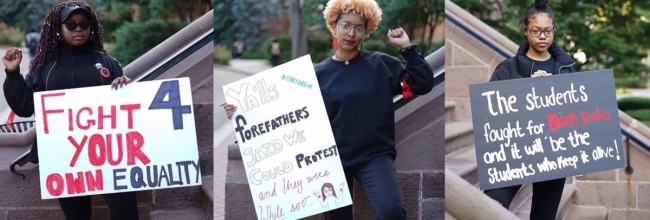You have /5 articles left.
Sign up for a free account or log in.

Seton Hall students protesting institutional racism
The Concerned 44
Friday marked the end of a 10-day sit-in at Seton Hall University. A group of students called the Concerned 44 had occupied Presidents Hall, where the university's administrative offices are housed, and vowed to stay until university officials adequately respond to their demands to address what they considered institutional racism.
Mary Meehan, interim president at the university, sent a message to students, faculty and staff on Friday announcing the end of the sit-in.
"The university is committed to an ongoing dialogue," the email read. "Going forward, university leadership will meet with representatives of Concerned 44 to clearly define the plan moving forward to create a more inclusive community at Seton Hall."
Briana Peterson, a sophomore psychology major and one of the organizing members of the Concerned 44, said the sit-in was put on pause during negotiations between students and university officials but that the group will "continue demonstrations if need be."
Tensions on the New Jersey campus continued to rise through the duration of the protest, leading to multiple additional protests, a series of meetings between students and administrators, a scuffle between a student and a professor, and the relocation of the president's and provost's offices.
More than 300 of Seton Hall's 9,800 students participated in the protest. The group was named for the 44 percent of students at Seton Hall who are “in the minority,” whether that be for their race, color, sexual orientation or gender identity. According to federal data, 47 percent of students at Seton Hall are white, 10 percent are Asian, 9 percent are black/African American and 18 percent are Hispanic/Latino.
“The students are the ones who make the money for the school, and they’re also the ones who need to feel welcome on campus,” Peterson said.
The group created a list of five demands, born from the 18 submitted by student activists to the administration last year. Their demands include hiring full-time faculty dedicated to the Africana studies program and the Latino studies and Latin American studies program. Both programs are currently staffed by part-time faculty or faculty split between departments. The students are also calling for a reconstruction of the university’s Office of Equal Employment Opportunity and Title IX Compliance; university-allocated funding for black history, Hispanic-Latino history, women’s history and Islamic history months; and a permanent student review board to help oversee faculty hiring at the university.
After the demands were submitted at the beginning of the sit-in, university officials issued a formal response and have held multiple meetings with the students. In its response, the university agreed to conduct a review of the Office of EEO and Title IX Compliance and to increase the budgets for black history, women’s history, Hispanic-Latino history and Islamic history months by 50 percent.
The faculty will be “asked to consider” student participation in faculty hiring, which already occurs to some degree in multiple departments, and the university will convene a task force composed of three students, three faculty members and three administrators to develop “a plan for promoting an educational environment that is both responsive to the educational needs of a diverse student body, and financially sustainable.”
Despite the university's response, students from the Concerned 44 remained in Presidents Hall for another week. They felt they could not agree to proposals without necessary details and were put off by the task force, which they did not ask for, nor do they want, according to the Concerned 44's written response.
Peterson is skeptical of university diversity initiatives after the university started the Talent of Inclusion project, which issued five tokens to first-year students upon arrival, which they could then give to other students they witnessed “performing an act of inclusion or welcome.”
"[A student] would pick up a black person’s pencil or help a Muslim student with their book bag, and they would get a coin,” she said. “We felt like it was a mockery of the struggle that students of color had on campus.”
Technically, the sit-in was scheduled to end last Sunday, per the university’s protest policy, which dictates that all organizers must submit an application for approval by the dean of students' office at least 48 hours in advance of the protest. Doing so gives the university the rights to “designate time, manner, and appropriate areas for the assembly” for the protest.
The protest policy prohibits many forms of protest, including “interfering with university operations, activities, and/or events,” “preventing access to or egress from offices, building or other university property,” “failing to comply with the directions of university officials, including directions to leave a particular facility or space” and “exceeding noise levels and/or interfering with or disrupting university operations,” among others. Any student who is found in violation of the policy “will be subject to disciplinary action and/or criminal charges.”
That’s the policy that Tracy Gottlieb, vice president for student services, cited in an email to student leaders five days after the sit-in began.
“I am writing to formally notify you that the students who remain in Presidents Hall are in violation of university policies. The sit-in protest in Presidents Hall was approved for three days and that time is now past,” she wrote. “Dr. Meehan met with those assembled in Presidents Hall on Friday, Oct. 26, at 5 p.m. Dr. Meehan asked at that time that all students leave Presidents Hall in compliance with the approved protest application.”
She added that the email serves as an “official notice” of violation of university policies, but did not disclose the potential repercussions for remaining in Presidents Hall.
Peterson said that the university did not take action against the students. Instead, the president and the provost moved their offices to the Bethany Hall, across campus. According to Peterson, the building was locked down with security posted at the door, and no one was allowed in the building unless their name was on a list. Laurie Pine, a spokeswoman for the university, would not say whether they had moved back to Presidents Hall at the end of the sit-in.
In addition to the sit-in, students held a protest at noon on Monday of last week during which they entered the University Club, a buffet and dining area for faculty. Students allege that at that protest, Williamjames Hoffer, a history professor, shoved Emani Miles, a student organizer with the Concerned 44. Hoffer denies shoving Miles.
“The only person who was harassed … actually physically abused was me by a full time faculty member … a history professor,” Miles tweeted Monday.
Hoffer said that he felt physically threatened by the students, and though he denies shoving Miles, he does recall brief physical contact.
“The physical contact that they are complaining of is when I held out my hand to tell them to stop, and came in contact with one of the student’s shoulder. I withdrew the hand immediately and we proceeded to engage in a very heated exchange, because they were shouting at me and I couldn’t be heard,” Hoffer said.
Video footage of part of the incident shows a heated conversation between Hoffer and the students, but no physical contact. At one point, another faculty member appears to be preventing Hoffer from engaging further with the students, but Hoffer also denies that he needed to be “held back” by other faculty.
Pine issued the following statement in response to the incident.
“Seton Hall was informed earlier today of an alleged incident between a faculty member and a Concerned 44 student protestor while protesting inside the Faculty Lounge. The university takes allegations of this nature very seriously and urges the student involved in this incident to come to Public Safety so the matter can be investigated,” the statement read in part.




